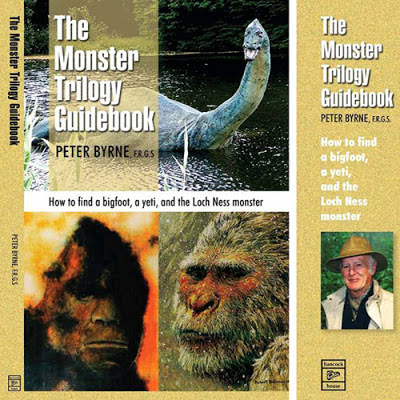
July 11, 2013
 |
| Cover art for Peter Byrne’s Monster Trilogy Guidebook |
For Bigfoot insiders Joe Beelart needs no introduction. Cliff Barackman has referred to him as “The King of Clackamas,” a title earned by Joe’s extensive research of Bigfoot encounters in the Oregon’s Clackamas region.
Peter Byrne’s new book The Monster Trilogy Guidebook is exactly what it should be; a foundation stone of Bigfoot literature based on six decades of well-funded field work in the Himalaya, Pacific Northwest, and Scotland. In it, Byrne straightforwardly tells the reader he has never seen one of his monsters; but he assures us they live! And, he encourages the peaceful pursuit of proving their existence.
Serious researchers should purchase a copy and study it. Probably, this is not a book for casual or new aspirants in the subjects for Byrne does not delve deep into history, list tables of sightings, tell tales of times past and grandiose expectations for the future, etc. Rather, he tells the serious enthusiast how to go about field research with the reasons for his suggestions based on what is possibly the most field time ever accumulated by one man in any outdoor pursuit. In short, Byrne shares hard earned experience; researchers should heed his words.
While Byrne barely comments on it, the theme of this memoir is conservation. Only in passing does he mention the great White Grass Plains Wildlife Reserve he established in southwest Nepal under the auspices of the International Wildlife Conservation Society, and the patronage of the Nepalese royal family. In conservation circles, the White Grass Plains is widely recognized as one of the most important achievements of the last half of the twentieth century. For his work Byrne was honored with awards by the Royal Geographic Society, London and the Explorer’s Club of New York, among other high profile groups.
When Byrne encourages ready-at-hand still and video cameras to capture and prove the reality of Bigfoot, the Yeti, and the Loch Ness monster; instead of shooting them with a powerful rifle, we see his concern for the creatures and their future. He also stresses practicing with a camera until its operation is second nature, for an encounter of a lifetime may last only seconds, or if lucky, minutes, and from experience as an investigator Byrne tells us when that encounter occurs, in all likelihood the witness will be shaken.
With those brief notes I assessed the general value of this book, established the principles of the book, and offered a snippet of the many suggestions Byrne makes on conducting field research. Now, a few observations about how it is written. Byrne is an expert writer and story teller. I own at least seven of his books which include Himalayan and Indian history, novels, and his early Bigfoot book. I have enjoyed every one. So when I say I feel there is a hint of disdain in The Monster Trilogy Guidebook toward our favorite monster – Bigfoot – I have a basis for my remark.
Or, perhaps it is more accurate to say Byrne may hold a bit of derision toward a segment of Bigfoot “researchers” and enthusiasts who maybe an audience for this book; the gee-whiz folks. Make no mistake; in the sixteen (16) chapters he devotes to the subject, he professionally covers a lot of ground fast, possibly to the point of being brusque. But, there seems to be a lack of liveliness, understated humor and attraction to the subject which is so prevalent in his other works.
It is as if Byrne knows he must address a topic, does so, and then goes on to the next. A telling hint is the title of Chapter 16: “Go Get ‘Em.” Why not use a little more encouraging title like “Onward?” Maybe it’s because Byrne has spoken so many times to so many people that don’t read, have not gone into the hills and, even if they can, never will. Maybe he is tired of people, who in the American way, want superficial entertainment from Bigfoot talks and films.
There is a decided change in attitude when Byrne writes about the Yeti. Again there are sixteen (16) short chapters, but these are filled with wonder and humor and technical tips beyond compare or imagination. Truly, Byrne’s love of the Himalaya shines in this wonderful section. It is contagious. And in the Himalaya, I’m quite sure Byrne did not speak to crowds; or perhaps hold back information due to contract constraints as may have been required in his Bigfoot research.
Finally Byrne talks about the Loch Ness Monster. This section will make you smile. For certain, Byrne was on a hillman’s holiday as he rode boats, glassed Loch Ness waters, and enjoyed pleasant hospitality searching for one of the most celebrated monsters in the world. And in this section, in quiet ways, Byrne pays both tribute and respect to the rich men who funded his expeditions. For those rich men knew, when they wrote the checks, that they were engaging a personable, honest, fit, quietly eloquent man who would represent their interests and names in impeccable fashion. Thank those men, and the man who lived their dreams, and maybe yours, for this fine book.Joe Beelart
About Guy Edwards
Psychology reduces to biology, all biology to chemistry, chemistry to physics, and finally physics to mathematical logic.
Guy Edwards is host of the Portland, OR event HopsSquatch.com.
Filed under Abominable Snowman, Bigfoot, Bigfoot Lunch Club, Books, Cryptozoologists, Cryptozoology, Expedition Reports, Folklore, Footprint Evidence, Lake Monsters, Loch Ness Monster, Men in Cryptozoology, Sasquatch, Yeti